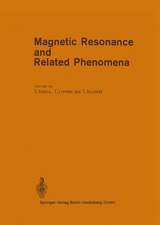Totally Accessible MRI: A User's Guide to Principles, Technology, and Applications
Autor Michael L. Lipton Cuvânt înainte de E. Kanalen Limba Engleză Paperback – 19 feb 2008
Preț: 911.74 lei
Preț vechi: 959.72 lei
-5% Nou
Puncte Express: 1368
Preț estimativ în valută:
174.50€ • 181.47$ • 146.02£
174.50€ • 181.47$ • 146.02£
Carte tipărită la comandă
Livrare economică 14-28 martie
Preluare comenzi: 021 569.72.76
Specificații
ISBN-13: 9780387488950
ISBN-10: 0387488952
Pagini: 313
Ilustrații: XXII, 384 p. 153 illus., 7 illus. in color.
Dimensiuni: 155 x 235 x 13 mm
Greutate: 0.59 kg
Ediția:2008
Editura: Springer
Colecția Springer
Locul publicării:New York, NY, United States
ISBN-10: 0387488952
Pagini: 313
Ilustrații: XXII, 384 p. 153 illus., 7 illus. in color.
Dimensiuni: 155 x 235 x 13 mm
Greutate: 0.59 kg
Ediția:2008
Editura: Springer
Colecția Springer
Locul publicării:New York, NY, United States
Public țintă
Professional/practitionerCuprins
In the Beginning: Generating, Detecting, and Manipulating the MR (NMR) Signal.- Laying the Foundation: Nuclear Magnetism, Spin, and the NMR Phenomenon.- Rocking the Boat: Resonance, Excitation, and Relaxation.- Relaxation: What Happens Next?.- Image Contrast: T1, T2, T2*, and Proton Density.- Hardware, Especially Gradient Magnetic Fields.- User Friendly: Localizing and Optimizing the MRI Signal for Imaging.- Spatial Localization: Creating an Image.- Defining Image Size and Spatial Resolution.- Putting It All Together: An Introduction to Pulse Sequences.- Understanding, Assessing, and Maximizing Image Quality.- Artifacts: When Things Go Wrong, It’s Not Necessarily All Bad.- Safety: First, Do No Harm.- To the Limit: Advanced MRI Applications.- Preparatory Modules: Saturation Techniques.- Readout Modules: Fast Imaging.- Volumetric Imaging: The Three-dimensional Fourier Transform.- Parallel Imaging: Acceleration with SENSE and SMASH.- Flow and Angiography: Artifacts and Imaging of Coherent Motion.- Diffusion: Detection of Microscopic Motion.- Understanding and Exploiting Magnetic Susceptibility.- Spectroscopy and Spectroscopic Imaging: In Vivo Chemical Assays by Exploiting the Chemical Shift.
Recenzii
From the reviews:
"This book presents a nonmathematical introduction to magnetic resonance imaging (MRI), covering all major topics … . The author, an expert in body MRI, has covered the major topics that are relevant for residents, physicians, students, and technologists. … Overall, this is a good introduction that will be useful for people entering the MRI field; the nonmathematical derivations can be grasped easily. The step-by-step pulse sequence breakdown is useful and interested readers will be able to seek the further information without any difficulty." (Michael A. Jacobs, Doody’s Review Service, September, 2008)
“Totally Accessible MRI provides an introduction to the principles of magnetic resonance (MR) imaging physics and practical use of MR imaging technology. … It will probably be most useful to residents beginning their MR rotations particularly those with an interest in neuroradiology. It also provides a concise review for my one interested in a deeper understanding of MR imaging and it is likely that even expert users will pick up a few pearls along the way.” (James F. Glockner, Radiology, Vol. 255 (2), May, 2010)
"This book presents a nonmathematical introduction to magnetic resonance imaging (MRI), covering all major topics … . The author, an expert in body MRI, has covered the major topics that are relevant for residents, physicians, students, and technologists. … Overall, this is a good introduction that will be useful for people entering the MRI field; the nonmathematical derivations can be grasped easily. The step-by-step pulse sequence breakdown is useful and interested readers will be able to seek the further information without any difficulty." (Michael A. Jacobs, Doody’s Review Service, September, 2008)
“Totally Accessible MRI provides an introduction to the principles of magnetic resonance (MR) imaging physics and practical use of MR imaging technology. … It will probably be most useful to residents beginning their MR rotations particularly those with an interest in neuroradiology. It also provides a concise review for my one interested in a deeper understanding of MR imaging and it is likely that even expert users will pick up a few pearls along the way.” (James F. Glockner, Radiology, Vol. 255 (2), May, 2010)
Textul de pe ultima copertă
This practical guide offers a lucid introduction to the principles of MRI physics. The author, recognized in the imaging community for his exceptional teaching methods and lectures, has written an easy to understand text. Each chapter explains the "why" and "how" behind MRI. Readers will understand how altering MRI parameters will have many different consequences for image quality and the speed in which images are generated. Practical topics, selected for their value to clinical practice, include progressive changes in key MRI parameters, imaging time, and signal to noise ratio. A wealth of high quality illustrations, complemented by concise text, enables readers to gain a thorough understanding of the subject without requiring prior in-depth knowledge.
Caracteristici
Presents complex material at simple levels Contains actual MRI images, not just diagrams An extension of the Horowitz book - much more comprehensive Includes supplementary material: sn.pub/extras















